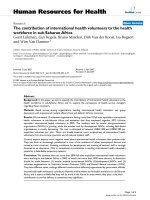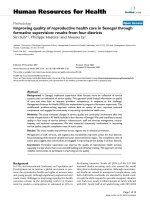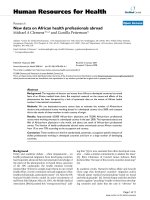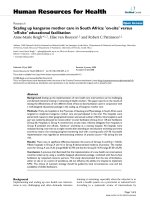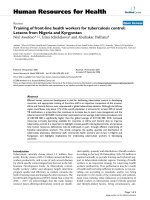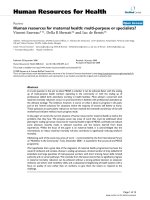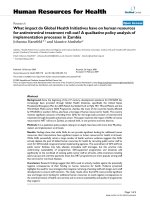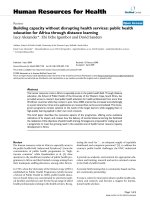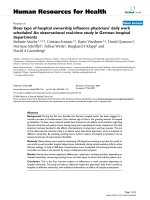báo cáo sinh học:" Scaling up proven public health interventions through a locally owned and sustained leadership development programme in rural Upper Egypt" ppt
Bạn đang xem bản rút gọn của tài liệu. Xem và tải ngay bản đầy đủ của tài liệu tại đây (352.89 KB, 6 trang )
CAS E STU D Y Open Access
Scaling up proven public health interventions
through a locally owned and sustained
leadership development programme in rural
Upper Egypt
Morsi Mansour
1
, Joan Bragar Mansour
1*
, Abdo Hasan El Swesy
2
Abstract
Introduction: In 2002, the Egypt Ministry of Health and Population faced the challenge of improving access to
and quality of services in rural Upper Egypt in the face of low morale among health workers and managers.
From 1992 to 2000, the Ministry, with donor support, had succeeded in reducing the nationwide maternal mortal-
ity rate by 52%. Nevertheless, a gap remained between urban and rural areas.
Case description: In 2002, the Ministry, with funding from the United States Agency for International
Development and assistance from Management Sciences for Health, introduced a Leadership Development
Programme (LDP) in Aswan Governorate. The programme aimed to improve health services in three districts by
increasing managers’ ability to create high performing teams and lead them to achieve results.
The programme introduced leadership and management practices and a methodology for identifying and addres-
sing service delivery challenges. Ten teams of health workers participated.
Discussion and evaluation: In 2003, after participation in the LDP, the districts of Aswan, Daraw and Kom Ombo
increased the number of new family planning visits by 36%, 68% and 20%, respectively. The number of prenatal
and postpartum visits also rose.
After the United States funding ended, local doctors and nurses scaled up the programme to 184 health care facil-
ities (training more than 1000 health workers). From 2005 to 2007, the Leadership Development Programme parti-
cipants in Aswan Governorate focused on reducing the maternal mortality rate as their annual goal. They reduced
it from 85.0 per 100,000 live births to 35.5 per 100,000. The reduction in maternal mortality rate was much greater
than in similar governorates in Egypt. Managers and teams across Aswan demonstrated their ability to scale up
effective public health interventions though their increased commitment and ownership of service challenges.
Conclusions: When teams learn and apply empowering leadership and management practices, they can transform
the way they work together and develop their own solutions to complex public health challenges. Committed
health teams can use local resources to scale up effective public health interventions.
Introduction
For ministries of health around the globe, well led and
managed health programmes are crucial f or producing
health improvements that can be maintained. In Aswan
Governorate in Egypt, a locally led and sustained leader-
ship development programme (LDP) has empowered
health workers in more than 180 primary health care
facilities to contribute to improvements in health. The
participants in this programme did what many others
have been unable to do: when external support ended,
they took a successful programme and expanded it.
With the benefit of many years of donor funding,
Egypt succeeded in reducing the maternal mortality
ratio (MMR) from 174 per 100,000 live births in 1992-
1993 to 84 in 2000. The rapid decline in the MMR was
due to factors that included “improved access to and
* Correspondence:
1
Management Sciences for Health, Cambridge, Massachusetts, USA
Mansour et al . Human Resources for Health 2010, 8:1
/>© 2010 Mansour et al; licensee BioMed Central Ltd. This is an Open Access article distributed under the terms of the Creative
Commons Attribution License ( which permits unrestricted use, distribution, and
reprodu ction in any medium, provided the original work is properly cited.
quality of maternal and reproductive health services,
reduced fertility rates, prenatal care utilization and
skilled attendance at delivery” [1].
Inspiteofmanyimprovements,however,gaps
remained in access to and quality of services, especially
in underdeveloped governorates. In Upper Egypt the
MMR averaged 89 per 100,000 in 2000, while urban
Egypt had an MMR of 46 [1]. Aswan, a governorate of
more than two million people, is typical of the gover-
norates in Upper Egypt, with a rural and mostly impo-
verished population.
Weaknesses in management at the local level are a
major barrier to impr oved health outcomes. In 2007 the
World Health Organization (WHO) noted that: “Weak-
nesses in general managerial capacity at all levels of the
health system, but especially at the local level, are widely
cited as a binding constraint to scaling up health ser-
vices and achieving the MDGs. Scaling up depends on
having some key resources, but it also depends to a
large degree on how those resources are managed” [2].
Although management strengthening is needed,
“attempts to strengthen district level health teams have
often been limited by the policy and practice of national
level government and donor agencies [and] by the
extent to whic h donor-supported programmes were still
based on standardized models which did not allow for
varying and complex environments at district level” [3].
In 2002 the Popula tion Sector of the Egyptian MOHP
identified “the l ack of commitment of front line health
workers” as one of its greatest challenges. After Dr.
Morsi Mansour, the Coordinator of Population and
Family Planning Projects in Upper Egypt for the MOHP
attended the Implementing Best Practices Conference
and heard about the leadership and management prac-
tices presented by Management Sciences for Health
(MSH), the MOHP asked the United States Agency for
International Development (USAID) Office of Popula-
tion to fund a one-year LDP in Aswan.
Case description
The LDP differed from previous leadership training pro-
grammes, which had targeted only senior-level leaders.
Its methodology is based on teams of health workers
working together on service delivery challenges in their
workplaces, with support and feedback from local
managers.
In June 2002, with support f rom Dr Ayman Ragab,
General Director of Health for the governorate of
Aswan, the LDP pilot, co -led by MSH and t he MOHP,
was launched f or 10 teams of doctors, nurses and mid-
wives.Theteamscamefromfiveprimaryhealthunits,
three districts and one rural hospital and included one
team of governorate managers. Over several months,
these teams participated in four one- or two-day
workshops, learning leadership and management prac-
tices (see Figure 1) and applying simple planning and
performance improvement tools to identify and ad dress
their challenges.
The purpose of the LDP was to empower local man-
agers and health workers to improve the quality and
accessibility of health services. The programme sup-
ported district and health facility teams in leading per-
formance improvement projects to address service
delivery challenges, increasing their skills in mobilizing
local resources, monitoring results and improving the
climate in their work groups and workplaces.
The LDP used two tools to guide the work. Teams
used the Challenge Model to work together towards a
shared vision of the health outcomes they desired. The
second tool, the Leading and Managing Practices Frame-
work, provided a simple way to understand the leader-
ship and management activities required to enable
others to face challenges and achieve results (Fig 2).
Each team assembled baseline d ata and established a
measurable performance goal. The teams designed pro-
jects to increase access to family planning services and
prenatal and postpartum visits and carried out the pro-
jects in their clinics or districts. MOHP managers led
monthly meetings to support the teams. Team meetings
led by participants involved clinic staff–not just the LDP
participants–in designing and carrying ou t the perfor-
mance improvement projects.
Participants learned essential leading and managing
practices: how to scan their environment and focus on a
priority challenge; align and mobilize their teams and
their stakeholders; and inspire each other. They learned
to manage their resources–to plan, organize and imple-
ment act ivities–and to monitor and evaluate their
results (see Fig 2).
The challenges required t hem to work together as
aligned teams for the first time:
“Before the programme , if I needed something I
would put in a request and if no one responded
to my request, I would do no thing. Now o ur
thinking is different. We try to do everything we can
to help our patients and clients, not just our
assigned tasks,” said Jasmine Boshra Abdollah, a
nurse in the Maternal and Child Health Center in
Kom Ombo.
To build sustainability into the LDP workshops and
team meetings, they were led in Arabic by MOHP facili-
tators. Exercises were reviewed by Ministry facilitators
to ensure that they would be understood and accepted
in the local context. Local managers facilitated short ses-
sions of the prog ramme and led district meetings
between workshops to reinforce learning.
Mansour et al . Human Resources for Health 2010, 8:1
/>Page 2 of 6
Figure 1 The challenge model.
Mansour et al . Human Resources for Health 2010, 8:1
/>Page 3 of 6
Discussion and evaluation
At the end of the first year, eight of the 10 health teams
had achieved 95% or more of their desired results and
had selected a new challenge without prompting [4].
Three districts–Aswan, Daraw and Kom Ombo–
increased the number of new family planning visits by
36%, 68% and 20%, respectively, compared to the same
period the year before. Three teams achieved notable
increases in the average number of prenatal care visits
per client. Gaafra Health Centre achieved an average of
3.6postpartumvisitsperclientasoftheendofJune
2003, up from 0.2 visits in June 2002 [4].
MSH conducted studies in 2003, 2004 and 2005 to
evaluate the results and learn more about the expansion
of the self-directed programme. In 2003, at the end o f
the one-year pilot, they found that:
• All teams had changed from complaining about pro-
blems to identifying actionable challenges they could
address.
• All teams collected complete or partial data on their
select ed challenges and used the data to prepare written
action plans with measurable outputs, time frames and
defined human and financ ial resources. There had been
a major change, from merely sending routine reports to
the next level to analysing the data to monitor progress
and understand their challenges.
• All action plans used existing resources available to
the teams; none required new human or financial
resources.
Teams from the programme were eager to go to Cairo
to present their success to the Ministry and demonstrate
that by improving their own leadership they had
improved service indicators. Nurses were among the
proudest presenters.
Sustaining and scaling up the programme
When USAID funding ended after one year, i n 2003, Dr
Abdo El S wesy, an o bstetrician/gynaecologist from Kom
Ombo District Hospital, and Dr Mohamed Souror, the
District Family Planning Director from Kom Ombo Dis-
trict, convened a group of participants to discuss how to
continue without outside funding. They faced many
challenges initially. In the donor-funded LDP pilot, par-
ticipants had attended meetings in hotels and received
allowances for food a nd transportation. In the second
year, meetings were held at health facilities, and the
costs of materials and transportation came out of
Figure 2 Leading and Managing Practices Framework.
Mansour et al . Human Resources for Health 2010, 8:1
/>Page 4 of 6
facilitators’ and participants’ pockets. Nevertheless, parti-
cipation remained high. Using a 10-page booklet of
handouts and modules adapted from the origin al pro-
gramme, facilitators from the three districts took the
revised programme to 15 new health facilities.
In the second year, teams from Aswan District raised
the number of prenatal visits per woman from 1.3 to
3.7, and child care visits increased from 1.1 to 3.5.
These improvements helped to change clients’ percep-
tions of the health facilities a nd workers a nd influenced
other health practices positively. The second generation
of the Kom Ombo team created a new medical informa-
tion system, and teams continued to increase the use of
contraceptives, including condoms, pills, injec tab les and
IUDs [4]. To achieve this, they implemented low-cost
activities that could be accomplished by clinics using
their own existing resources, including home visits,
training for service providers and health education for
women, men, and community leaders.
In the third year, the LDP scaled up to 100 health
facilities and by 2005 it had reached all 184 primary
health faciliti es–incl uding more than 1000 health work-
ers–in the governorate. Thirty-five local facilitators were
developed over five ‘generations’.
In 2004, an evaluation found that: “The LDP is per-
ceived as a powerful tool to improve performance by all
participants. The programme’s participatory approach
has enabled front line service providers to actively parti-
cipate in discussions and in the desig n an d implemen-
tation of their own small-scale service delivery
improvement projects, as opposed to conducting projects
‘imposed’ by higher levels of the h ealth system. This has
contributed substantially to participants’ enthusiasm and
ownership of their service delivery challenges” [5].
The LDP’s role in decentralization
In 2005 an evaluation report found that: “Service provi-
ders who participated in this programme improved their
commitment and love of their jobs They act as partners
to implement plans in their clinics rather than imple-
menting plans put in place by somebody else. Trained
health teams at the clinic level solve their own problems
and don’t wait for central level management to solve
their problems” [6].
The evaluation also found that everyone who shared
in the programme’s implementation w as motivated, the
programme was easy to implement and it was adjusta-
ble, meaning that it was possible to add to it or to take
things out as necessary [6].
The facilitators had problems that included:
• advocating the programme to higher management at
the governorate or central level;
• finding time to expand the programme when the
core team of facilitator s became v ery busy (in new man-
agement positions);
• addressing the turnover of doctors during the train-
ing. When this happened health workers in the facilities
had to bring new doctors up to date to be able to work
with the rest of the team.
Focusing on a governorate-wide challenge: reducing the
maternal mortality rate
After training all health facilities in the governorate, in
2005 the Aswan LDP facilitators chose the governorate-
wide challenge of reducing the MMR from 85 per 100
000 live births to 50. To accomplish this, LDP facilita-
tors brought Safe Motherhood Committees to every dis -
trict in the governorate. (These committees expanded
on governorate-level committees initiated by the USAID
Healthy Mother/Healthy Chi ld Project.) District com-
mittees scanned to discover the factors contributing to
maternal deaths in their areas. They focused on two fac-
tors that were within their control: (1) immediate trans-
port of haemorrhaging women to a district hospital, and
(2) a requirement that hospital physicians diagnose and
treat in a team of three to prevent unnecessary haste
and foster good decision-making under pressure. This
requirement reduced unnecessary procedures and com-
plications. [7]
Focusing on these two factors contributed to reducing
the MMR for the entire governorate–apopulationof
over two million. From 2006 to 2007, the Aswan Gover-
norate reduced the MMR further, from 50.0 per 100,000
live births to 35.5. This figure continues to drop at a
rate faster than in comparable governorates in Egypt.
Qena is a governorate in Upper Egypt with similar eco-
nomic and social conditions and similar amounts of
MOHP and donor-funded programmes. In 2006 the
MMR in Qena was 52.7 per 10 0,000, and in 2007 it was
52.0 per 100,000.
Developing a new generation of leaders for the health
system
Since completing the programme, more than 20 LDP
facilitators and participants have taken leadership roles
in the Aswan health directorate. The commitment of
the health workers in Aswan and the results they have
achieved over six years have come to the attention of
the centra l MOHP, and other governorates across Egypt
are requesting the LDP for their health teams.
Scaling up to new areas and countries
Aswan facilitators have transferred LDP approaches to
other governorates in Egypt. Through TAHSEEN, a
USAID-funded project implemented in Egypt by the
Catalyst Consortium, the Upper Egypt governorates of
Minya, Bani Swaif and Fayoum were trained in LDP
approaches and tools.
In 2005, Ministry of Public Health officials from
Afg hanistan went to Aswan to learn the LDP approach.
They replicated the programme in five Afghan provinces
that year. Now the LDP is used to improve service
Mansour et al . Human Resources for Health 2010, 8:1
/>Page 5 of 6
results in over 100 health facilities in 13 provinces
across Afghanistan.
The LDP has been t ransferred to 35 developing coun-
tries around the world, and is used to scale up a variety
of proven public health intervent ions. LDP tools and
approaches are also being introduced into medical and
public health curricula in Africa, Latin America and the
Eastern Mediterranean.
Conclusions
The LDP has scaled up with local resources because it
uses a simple process of working with teams over time
to focus on real health results, developing leaders at all
levels of the health system and enabling local health
managers to own the development process. It provides a
pathway for teams of health managers and providers at
all levels to lead and manage to improve performance.
Local leaders in Egypt saw that the programme pro-
duced results through this process and that it was easily
transferred with local ministry staff as facilitators. They
found inspiration and support in situations that were
previously filled with d espair. When technical assistance
is seen as a resource, but not the source, of improved
health, local leaders are free to be that source–to
choose, use, ‘own’ and sustain necessary improvements
in health care for their communities.
Lessons learnt
Toscaleupasustainableprocessforserviceimprove-
ment using available resources, we recommend the
following.
• Empower front-line managers and their teams with
leading and managing practices and a simple process for
improving service results that is based on their shared
vision of the health outcomes they want to achieve.
• Ensure that programme materia ls, processes and
tools are simple and easy to adapt and contribute to
measurable results that people care about.
• Support managers and their teams in playing the
lead role in facilitating, adapting and sustaining health
improvement programmes.
Acknowledgements
The one-year Leadership Development Programme and the subsequent
MSH evaluations were funded by the Office of Population and Reproductive
Health, Bureau for Global Health, United States Agency for International
Development, under the Management and Leadership Programme,
cooperative agreement number HRN-A-00-00-00014-00 .
Author details
1
Management Sciences for Health, Cambridge, Massachusetts, USA.
2
Aswan
Health and Population Directorate, Ministry of Health and Population, Aswan,
Egypt.
Authors’ contributions
MM organized the technical and other resources to lead the original LDP in
Egypt. JBM brought the applied transformational leadership models and
practices to Egypt and worked with MM and a team of Egyptian consultants
to design the contents of the LDP. AES led the scale-up process of the LDP
in Aswan- including the adaptation of local training materials and
development of 35 local facilitators. All authors contributed to and approved
the final manuscript.
Authors’ information
From 2000-2003 MM was Coordinator of Family Planning and Reproductive
Health in Upper Egypt, Ministry of Health and Population, Egypt; he is
currently a Leadership Development Specialist at Management Sciences for
Health, Cambridge, Massachusetts, United States of America. JBM is a
Leadership Development Consultant for Management Sciences for Health. In
addition to his post with the Ministry of Health and Population, Egypt, AES
is also Director of the Infection Control Department and obstetrician and
gynaecologist, Kom Ombo District Hospital, Aswan, Egypt.
Competing interests
MM and JBM are employed by Management Sciences for Health (MSH).
MSH financed the writing of this article and the article processing fee.
Received: 1 March 2009
Accepted: 19 January 2010 Published: 19 January 2010
References
1. Gipson R, El Mohandes A, Campbell O, Issa AH, Matta N, Mansour E: The
trend of maternal mortality in Egypt from 1992-2000: an emphasis on
regional differences. Matern Child Health J 2005, 9(1):71-82.
2. Egger D, Ollier E: Managing the health Millennium Development Goals:
the challenge of management strengthening: lessons from three
countries. Making Health Systems Work: Working Paper No. 8 WHO/HSS/
healthsystems/2007.1 Geneva (Switzerland): World Health Organization,
Department for Health Policy, Development and Services 2007, 39.
3. Conn CP, Jenkins P, Touray SO: Strengthening health management:
experience of district teams in The Gambia. Health Policy Plan 1996,
11(1):64-71.
4. Topçuoğlu E: Evaluation of the Leadership Development Program for the
Ministry of Health and Population, Egypt. Cambridge (MA): Management
Sciences for Health 2003, Cooperative Agreement No.: HRN-A-00-00-00014-
00.
5. Topçuoğlu E: Follow-up Evaluation of the Leadership Development
Program for the Ministry of Health and Population, Egypt. Cambridge
(MA): Management Sciences for Health 2004, Cooperative Agreement No.:
HRN-A-00-00-00014-00.
6. Khalil T, Topçuoğlu E: Evaluation of the mainstreaming of the Leadership
Development Program in Aswan, Egypt. Cambridge (MA): Management
Sciences for Health 2005, Cooperative Agreement No.: HRN-A-00-00-00014-
00.
7. Alswasy AH: How to sustain an effective program after funding ends:
achieving results in a low resources country: an experience from the
Aswan Leadership Development Program, Aswan, Egypt, 2002-2006.
Presentation at the International Federation of Gynecology and Obstetrics
Conference; Kuala Lumpur, Malaysia 2006.
doi:10.1186/1478-4491-8-1
Cite this article as: Mansour et al.: Scaling up proven public health
interventions through a locally owned and sustained leadership
development programme in rural Upper Egypt. Human Resources for
Health 2010 8:1.
Mansour et al . Human Resources for Health 2010, 8:1
/>Page 6 of 6

